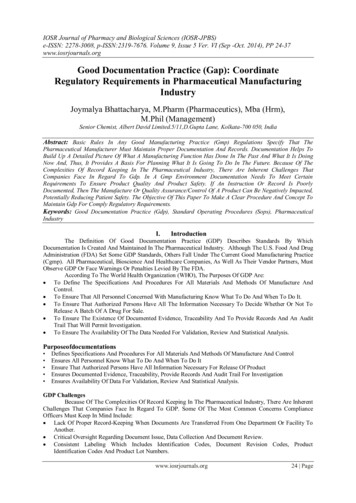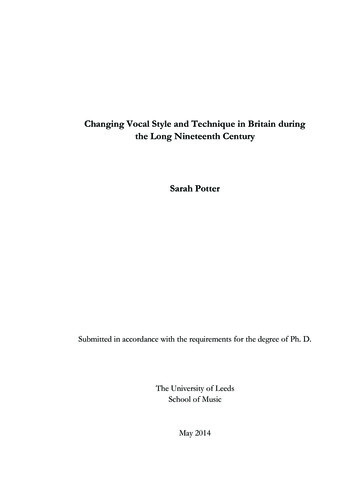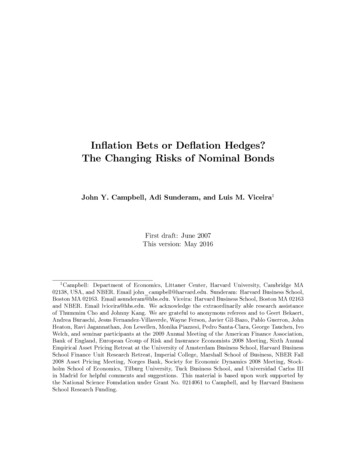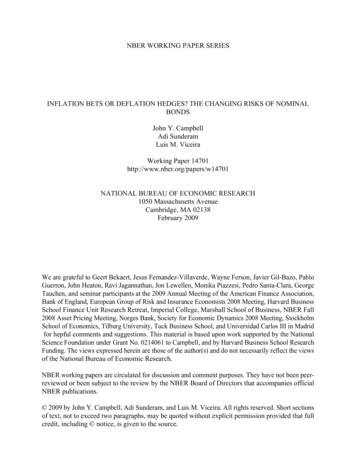
Transcription
Changing Coordinate SystemsIn previous lectures, I’ve told you that when I do physics problems, it doesn’tmatter what choice of coordinate system I make. Today I’m going to explorethis statement in a little more detail.Let’s imagine that I have two bodies in space, interacting gravitationally,shown in Figure 1. The force they experience depends on the distance betweenthem, and their two masses - we’ll have much more to say about Newton’s lawof gravitation in the coming lectures. I’ve included a choice of coordinates, andindicated the position vectors of each body.Figure 1: Two massive bodies will exert a gravitational force on each other,according to Newton’s law of gravitation. We’ll explore this law in more detailin coming lectures.Now, what if I wanted to make another choice of coordinate system? I’veindicated in Figure 2 the same physical system, but with another coordinatesystem chosen. This new coordinate system is drawn in blue, and I’ve labeledthe coordinate axes with primes. Now, because the position vector of an objectis defined with respect to the origin of some coordinate system, it becomes clearthat with a new set of coordinates, the position vectors of my bodies will change.This is also shown.Now, the question I want to ask is, how are the position vectors in the twocoordinate systems related to each other? To answer this question, I’ve alsodrawn another vector, d, which is the displacement vector from the origin ofthe first coordinate system to the origin of the second coordinate system. Using1
Figure 2: A second choice of coordinate system will, in general, lead to differentposition vectors.the laws of vector addition, it becomes clear thatr01 r1 d,(1)and likewise for the position of the second body. Alternatively, I could rearrangethis to writed r01 r1 .(2)This vector equation just says that if I start at the origin of the original coordinate system, move to the origin of the new coordinate system, and thenmove along the vector r01 , I’ll end up at the location of the first body. This iswhat I should expect, since the net result of moving from the origin of the firstcoordinate system to the first body is described by the displacement vector r1 .Now, despite the fact that I can use two different coordinate systems todescribe my physical problem, the forces experienced by the bodies should bethe same regardless. The forces are vector quantities which act on the bodies,and have an existence in their own right, independent of a choice of coordinatesystem. This is made explicit by the formula for the force. It depends on thephysical distance between the two bodies, and their masses, which are allquantities that have nothing to do with my choice of reference frame. So theforces are always the same, and so are the masses.The fact that this is true means that for either of the bodies, the expressionF/m, or the force on that body divided by its mass, is always the same, nomatter what choice of coordinates I pick, so thatF/m F 0 /m.2(3)
Now, I told you that the way that we actually determine the motion of a bodyis by using Newton’s second law,F/m a.(4)If it is indeed true that I can use any choice of coordinate system to do a physicsproblem, then Newton’s law should be true no matter which coordinate systemI choose. If it is, and the quantity F/m is the same regardless of the choice ofcoordinates, then it better be true that the acceleration is also the same in bothcoordinate systems.However, the acceleration is something which is defined in terms of the position vector. Since the position vector DOES depend on the choice of coordinatesystem, I had better be more careful in making sure that the acceleration vectoris actually the same. In the original coordinate system, I havea d2 r.dt2(5)Now, in the new coordinate system, I havea0 d2 r0d2 2 (r d) .2dtdt(6)However, the vector d is just a constant displacement vector, and so its timederivative is zero. Therefore, we finda0 d2 r a.dt2(7)So everything checks out.Galilean RelativityBut now let’s imagine I do something a little different. Imagine I were to pick anew frame whose origin was not sitting still with respect to the old frame, butinstead moving at a constant velocity with respect to the old frame. That is,imagine I hadd (t) d0 tvno ,(8)where vno and d0 are some constant vectors. Notice that the vector vno is thevelocity of the origin of the new frame with respect to the old frame. We can seethis because d is nothing other than the position vector of the origin of the newframe with respect to the old frame. If I therefore want to compute the velocityof the origin of the new frame, I need to compute the time derivative of d,ddd (d0 vno t) vno ,dtdt(9)as claimed. Because this vector tells me the velocity of the origin of the newcoordinate system with respect to the origin of the old coordinate system, we3
often just say that this is “the velocity of the new frame with respect to the oldframe.” The subscript “no” stands for “new with respect to old.”I now want to understand how this might change the physics of my problem.Again, so long as t 6 0, the position vectors with respect to one frame will bedifferent from the position vectors with respect to another frame. But, I canagain show that the accelerations will stay the same, and so Newton’s laws willstill be valid. If I compute the acceleration in the new frame this time, I finda0 d2d2d2 r0 (r d) (r d0 tvno ) .dt2dt2dt2(10)However, the second derivative with respect to time will kill off the second andthird terms, and so againd2 ra0 2 a.(11)dtThus, if Newton’s laws hold in the first frame, they also hold in the new frame.This result is called the principle of Galilean relativity, and the change of coordinate system we have performed is called a Galilean transformation.This result tells us that there is really no way to prefer one of these framesover the other. Newton’s laws, which we believe to be the “laws of physics,”hold the same way in both frames. So there is really no way we can say whichone is the “correct frame,” or which origin is the one sitting still.However, while the accelerations are the same, the velocities will be different.We can see this by considering the velocity of body number one in the new frame.What we find is thatv10 dr01d (r1 d0 tvno ) v1 vno .dtdt(12)We see that the velocity is shifted by the velocity of the new frame with respectto the old one. To make my notation a little more explicit, I can write this asv1n v1o vno ,(13)where the subscripts would be read as “body one with respect to new frame,”“body one with respect to old frame,” and “new frame with respect to oldframe.”Now, velocity transformations can be a little annoying, because it’s easy toaccidentally get the subscripts backwards, or be dyslexic about which frame iswhich. There is a notational method I find very helpful to make sure you havethe transformation correct. If I take the above equation and rearrange it, I havev1o v1n vno .(14)Notice that on the right side, the letter “n” shows up twice, once on the outsideof the two letters, and once on the inside. If I imagine these two copies of “n”“canceling”, then they leave me with simply “1o,”1n no 1o.4(15)
The result is the correct arrangement of subscripts on the left side.I can also generalize this formula a little bit. Imagine that I have threeobjects or points in space, A, B, and C, which are moving with respect to eachother. If I associate the origin of a coordinate system with two of them, andthen consider the velocity of the third object, what I have is thatvAC vAB vBC .(16)This equation says that the velocity of object A as observed from thelocation of C is the same as the vector sum of the velocity of objectA with respect to the location of object B, plus the velocity of objectB with respect to the location of object C . I find this form of the velocity addition law to be the easiest one to remember, because I simply imagine“canceling out” the two Bs.Another important property to remember is that for any two objects A andB,vAB vBA .(17)Intuitively, this says that if I think you’re moving to the left, you instead thinkthat I’m moving to the right. I can verify this claim pretty easily from lookingat Figure 2. If d is the position vector of the new frame with respect to theold frame, then certainly, d must be the position vector of the old frame, asviewed by the new frame, since d points in the opposite direction, from theorigin of the new frame to the origin of the old frame. When we take a timederivative to get the velocity, the minus sign carries through.These ideas are actually probably familiar to you already from freshmanmechanics, but to refresh our memory, let’s study an example of these ideas.Imagine I’m standing on the Earth and I fire a gun horizontally, as I’ve drawn inFigure 3. I’ve also set up a coordinate system centered around myself, indicatedin blue, with the bullet moving along the x direction, with velocity vb withrespect to my coordinates. For the sake of simplicity, I’ll ignore the effects ofgravity in this example (I’ll assume that I’m only worried about time periodsshort enough that the bullet hasn’t started to fall noticeably).I’ve also shown a car which I imagine happens to be driving by me as Ifire the gun. Let’s say that with respect to me, the car isn’t moving in they direction, but it is moving along the x direction with some velocity vc withrespect to me. Now, I’ve also drawn some coordinates centered around the car,labeled in red. If the driver of the car measures the velocity of the bullet, thenwe can use the velocity transformation rule to see that they will findvb0 vb vc .(18)If we want to be really careful that this is right, we can use the letter B for bullet,C for car, and G for ground (where I’m standing). Then the above equationsaysvBC vBG vCG vBG vGC ,(19)which obeys the rule for the subscripts that I mentioned previously.5
Figure 3: A demonstration of Galilean relativity, using the example of a bullettraveling through the air, as observed by the gunman and a driver passing by.Now, if I notice that the car is passing by me at the same velocity that Ifired the bullet, we havevb0 vb vb 0,(20)which is to say that according to the driver of the car, the bullet is sitting still.Of course, this makes sense. If the car drives by me at the same velocity as thebullet, the driver of the car should see the bullet travelling next to him, sittingstill with respect to his coordinates.Now, it is tempting to say that I am the one who is “really sitting still,”and that the car is actually moving. This is because I am on the ground, andthe surface of the Earth is familiar to us, for obvious reasons. However, weknow in reality that the Earth is actually moving through space, and doesn’treally represent any sort of special location. In fact, there is really no differencebetween the car’s choice of coordinates and mine. The driver of the car and Iwould both say that the bullet is moving at constant velocity, and so it is notaccelerating (at least not in the x direction). We also both agree that asidefrom gravity (which would only affect the y component anyways), there is noforce acting on the bullet (at least not in the x direction), since it is in free falland not in contact with anything. Thus, we both agree that the force and theacceleration are zero, and so we both agree that Newton’s second law is obeyed.Inertial Reference FramesLastly, what if I consider two reference frames whose relative velocities are notconstant? Let’s go back to our example in Figure 1, and imagine that d is now6
given by1d d0 vno t gt2 .(21)2That is to say, the second frame is moving with respect to the first in a way thatis quadratic in time, not linear - it is accelerating. If we now go to compute theacceleration of the first body, according to the new frame, we find d21d2 r0a0 2 2 r d0 vno t gt2 a g,(22)dtdt2and so the acceleration is NOT the same. However, we know that the forces arestill the same in both frames. Therefore, it cannot be true that Newton’s secondlaw is the same in both frames. If it is true in one, then it cannot be true in theother.The same idea can be examined in the case of the car and the bullet. If thecar were accelerating with respect to me, then to the driver, it would appear thatthe bullet had a net acceleration backwards, despite there not being any forcesacting on it in the x direction.Assuming that Newton’s law is correctly obeyed in the first frame, this frameis know as an inertial reference frame. The definition of an inertial referenceframe is one in which Newton’s laws are obeyed. We have seen that if I have aninertial frame, any other frame which is moving at constant velocity with respectto this frame will also obey Newton’s laws, and so it is also an inertial referenceframe. By starting with one inertial frame, we can find all other inertial framesby considering all of the frames moving with respect to it at constant velocity.However, any frames which are accelerating with respect to this frame will notobey Newton’s laws, and we call them non-inertial reference frames.When I first learned this fact, it seemed somewhat unsatisfying to me. Theresult we’ve found is that while the universe doesn’t seem to “know” what speedyou’re moving at, it does seem to be able to make a distinction between whichframes are accelerating, and which are not. Why should the first derivativeof position be totally unimportant, while the second derivative is absolutelycrucial?An even more unsettling example involves what happens if you stand withyour arms outstretched and spin around. Experience tells us that if I standstill, I feel nothing special. But if I start spinning around in a circle, I feel atension in my arms. This is because my hands are now moving in a circle, andso there is a force required to keep them accelerating, whic
Let’s imagine that I have two bodies in space, interacting gravitationally, shown in Figure 1. The force they experience depends on the distance between them, and their two masses - we’ll have much more to say about Newton’s law of gravitation in the coming lectures. I’ve included a choice of coordinates, and indicated the position vectors of each body. Figure 1: Two massive bodies .











